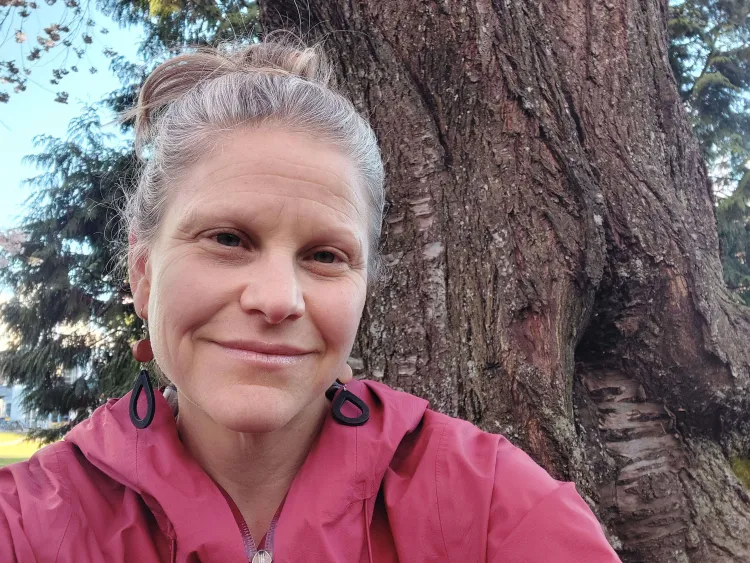The waters off southern Florida could have been mistaken for a hot-tub in recent summers, with temperatures so high they triggered coral reef bleaching events. We know coral reefs protect against storm surges and are biodiversity hotspots. We know they attract tourists. But how else do we determine the worth of coral reefs?
That is the sort of question Rachelle Gould, associate professor of environmental studies and the newly named Steven Rubenstein Professor for Environment and Natural Resources, ponders these days while working with the National Oceanic and Atmospheric Administration on their assessment of coral reefs. Gould heads UVM’s Ecocultural Values Workshop and studies the non-material value of ecosystems. These are the intrinsic and relational things we know are important but don’t have an easy way of cataloging when developing environmental policy.
The goal is not only to quantify, but to capture, she explains. “Maybe we can quantify some of these values but monetizing them is really hard.”
For instance, a walk in the woods can lower measured stress levels, but how do you weigh the origin story of a particular mountain by native people? What is the value of one’s shared history with a place? It’s like trying to put a price tag on love—we know we need it to thrive, but we cannot put a figure on it.
But environmental policy involves measurement. And some factors, like temperature, bird counts, and water quality are easier to track. Policymakers increasingly try to incorporate “ecosystem services,” a term to account for the benefits of nature that often use market-based values because it’s tidier to count the number of fish caught and their market value than the right of an endemic species to exist or the fulfilling relationships a community has with its river. So much of the intrinsic and relational value of an ecosystem is left outside of spreadsheets and policies because we can’t put a number next to it. This creates an imbalance where market-based values are favored in policies, short-changing the qualities we care about but do not always include.
“The dominant method that we have for representing what matters in environmental policy is monetization to be input into cost-benefit analysis,” Gould says. “But that doesn’t let us talk about many of the things that really matter.”
A better accounting for nature in policy
Gould has made it her life’s work to talk about the things that matter and integrate them into environmental policy. The Rubenstein professorship will help do this.
“Dr. Gould’s work at the intersection of environmental policy and planetary health, represents UVM’s important common ground values,” says Peter Newman, dean of UVM’s Rubenstein School of Environment and Natural Resources. “Her scholarship, teaching, and leadership make her an ideal fit for the Professorship. I have no doubt her appointment will enhance our capacity to address the most pressing challenges of our time.”

The professorship was established in 2013 by Steve and Beverly Rubenstein and comes with five years of funding to foster transdisciplinary research that engages community partners and students. Gould has proposed developing a graduate course to examine how non-monetary impacts of environmental impacts wellbeing. She intends to expand partnerships with agencies to incorporate nonmaterial valuations of nature into local and federal policy. She is already doing that with the National Oceanic and Atmospheric Administration. Since 2022, Gould has worked with economists at the agency to devise a new way to incorporate non-monetary value as part of its coral valuation study to determine what coral reefs are worth.
Previous iterations of the report have focused solely on economics, Gould says. “Analyses incorporate, for instance, how many fish get taken to eat or sell, how much tourists pay to scuba dive there, how many boat trips go, and how much the reefs contribute to shoreline protection.”
But for the current version, stakeholders asked NOAA to expand its valuation beyond traditional monetary benefits. Gould was invited to help develop additional measures. The report, once finalized next year, could serve as a template for other groups wanting to include non-monetary values in nature assessments.
The process has historically relied on using numbers to justify spending or priorities—even if the evaluations are incomplete, Gould says. “What we need is a different decision-making process that allows us to characterize benefits from the reefs for which a dollar value would be inadequate.”
She and the NOAA team will present preliminary findings in May, albeit in a different political environment than they began. In some ways, Gould says, this forces her to make her case stronger.
“This is a good encouragement to really clearly explain why understanding diverse values is so important,” she says.
The Rubenstein professorship allows Gould to continue her work in this arena.
Government entities are required to include cost-benefit analyses as part of their decision-making process, she explains, and federal guidance already notes that qualitative descriptions can be included when numbers don’t suffice.
The option exists, but there remains a hesitancy to use it, Gould says.
Her project aims to make using the qualitative option more palatable to government officials. The professorship comes at a time when working with federal partners has become harder with layoffs and shifting priorities, but Gould is determined there remains a way to integrate intrinsic and relational values into policy conversations. There are things that we can all agree are important, she says, “like freedom and clean water.”
There is room for overlap.
There is a path, Gould says, and she wants to blaze it.
Gould made headway last year when she was tapped to serve as a chapter lead for the country’s first National Nature Assessment, and effort to provide a more holistic view of the state of the land, water, and wildlife in the United States. The report was to describe the risks our natural resources face, and their economic and intrinsic contributions to human health and wellbeing. Her chapter on cultural heritage would mark the first time the non-material benefits of nature were included in a report of this magnitude in the United States, but mere weeks from releasing the first draft to the public, the report was cancelled by an executive order under the Trump Administration.
Taylor Ricketts, director of UVM’s Gund Institute for Environment, was also serving as a chapter author focused on the intersection between nature and human health and wellbeing. Since the assessment was cancelled, he and Gould have continued to work with scientists to finalize the report, but without support from federal partners initially involved in the effort.
Their first draft was just submitted and the sections will undergo peer review, Gould explains. The plan is to publish the report next summer—with or without the government’s help.
Making implicit values explicit
This is the type of work Gould believes is necessary for making environmental data digestible for policymakers. This is a way to provide a more comprehensive view for policymakers of what nature does for us—the things that matter to us culturally, spiritually, and psychologically, on top of the things we know that count like clean air, water, and crop pollination.
In 2022, she co-authored the United Nation’s Intergovernmental Platform on Diversity and Ecosystem Services (IPBES) assessment of the diverse values of nature. Gould then spent the 2022-23 academic year on a Fulbright grant in Mexico and Canada working with colleagues to more accurately express the value of nature in policy.
“Much of my career has been trying to come up better ways to characterize these non-material values for decision-making,” she says.
The Fulbright experience recalibrated her thinking. Rather than devising a single method to represent the value of natural systems in environmental policy, Gould suspects values are more likely be surfaced through a more inclusive process akin to what she found in several Indigenous territories in southern Mexico.
“They make decisions as a community about what they do with their land, and it is extremely democratic and extremely collective,” she explains. “They are including what matters in a way that formalized natural capital accounting is not. … They are doing it in a very democratic way that is not quantifying those values but is bringing them into play and discussing them.”
Making the implicit values of nature explicit to decision makers, Gould argues, leads to more equitable decisions—and government accountability.
“When these values are explicit it’s much harder to ignore the values of people with less power,” she says. “Those with power, can’t say they ‘didn’t know’ what was deeply important to a marginalized group.”


